
The doorbell rings and next there is a circus going on as your guests battle their way past your leaping dog. In the park, your pet takes off and smears five people with mud head to toe. Embarrassed and angry, you drag your wild canine home. It doesn't matter how loudly you yell OFF or how often people knee, kick or scream at the leaping beast, your pet just won't stop jumping up on people.
This isn't just an embarrassing problem. An elderly person could be badly injured by a large leaping dog. Many people have received scratches and bruises from jumping dogs. This is a bit of bad manners that needs to be fixed.
You may heard all kinds of reasons for jumping up, such as that the dog is trying to be dominant. But no, dogs jump up on people simply because people are tall and dogs are not. Your dog is trying to reach the person's face, more specifically the nose and mouth. You may have noticed that when dogs greet each other they usually present their faces to each other first. Dogs gather a lot of information from smelling the mouth and exhalations of breath- not something we humans understand at all.
Younger animals often jump up in an effort to perform a puppy greeting ritual. This bit of left-over behavior originated in young wolf puppies, who were left at home while the adults hunted. Not having pockets or backpacks, the adults transported meat back to the puppies in their stomachs. The young puppies eagerly greeted the adults by licking at their mouths, and the adults responded by producing meat. This bit of behavior has little actual relevance to domestic dogs, because mother dogs don't feed their puppies this way. But the greeting ritual remains-puppies greet their elders by licking at the mouth. Your puppy tries to do the same to you.
Another reason why dogs jump up on people is simply due to excitement. If you own more than one dog, you'll almost certainly have noticed that when one dog leaves and then comes back, the greeting ritual often quickly degenerates into wild rough-housing as the excited animals try to express their excitement and delight. Roughhousing dogs jump and leap around and play-bite at each other's necks, which is oddly similar to your dog's behavior when guests come over, isn't it?
So your dog starts out jumping up on people because he is trying to reach the face in order to perform various instinctive doggy greeting behaviors. Many dogs then continue jumping up on people because they get rewarded for doing so. They get attention. It's hard to ignore a leaping dog, so leaping dogs get petted, touched, yelled at, shoved, chased, grabbed- it's all good from your pet's point of view. Attention, even negative attention, is highly rewarding to dogs.
From the operant conditioning point of view we don't have to understand at all why an animal does something in order to change the animal's behavior. All we have to do is change the consequences of the behavior. If we want to stop an animal from doing something, permanently, the obvious solution to most people is punishment. Punish the behavior and stop it.
However, we know punishment rarely stops jumping up. That's what people try first and foremost to stop jumping up, and it doesn't work which is why so many dogs continue to jump. Frustrated dog owners don't know what else to try so they tend to escalate the punishment and it still doesn't work. A few timid pets may respond to severe physical punishments and stop jumping, but for most dogs it really is a very ineffective approach.
Most people try various forms of physically punishing their dog- they slam their knee into the dog's chest as the dog jumps, throwing the animal backwards. Some people stomp on the dog's feet, or shove the dog hard, or yank on the leash. Others yell vigorously at the dog- NO, or OFF being popular. So why don't these measures work? Well, keep in mind that your dog, being a dog, is kind of expecting a fun wrestling match to occur during greeting- and from his point of view, your shoving and kneeing and vocalizing is exactly that. Many dogs think you're trying to wrestle in greeting when you do these things, and this encourages them to jump up even more. It's all attention, and attention is good. You're actually rewarding your dog for jumping when you try to punish your dog this way.
With puppies, using punishment for jumping up is simply bewildering to them. Keep in mind that puppies instinctively lick at the mouth of adults in greeting. The puppy is saying "Hi I'm a puppy don't hurt me", so when you respond by slamming your knee into the puppy it's very confusing to the puppy. Many puppies respond by trying ever-harder to get to the people's mouth and lick, which means more and more jumping. Again, physical punishment actually encourages jumping.
What about using some kind of non-physical punishment? One method some people have tried is a remote collar. The dog is fitted with the collar, and whenever his feet leave the ground to jump on someone, the collar is triggered to deliver an aversive- a low-level electrical shock, a vibration, or a spray. When the dog's feet hit the ground, the aversive is turned off. This does actually work quite well- sometimes. Occasionally something really bad happens- the dog doesn't understand where the unpleasant sensation came from, and naturally blames the closest person for the unpleasantness. We have seen some dogs accidentally learn to be terrified of strangers or aggressive towards strangers in response to the use of a remote collar to try to curb jumping up. Usually the fault is in how the remote collar is used- the dog hasn't been properly trained to respond to the remote collar before it is used. We suggest you do some extensive research in how to use a remote collar before attempting to use one on your pet. While it is a useful, wonderful bit of training technology, it takes quite a bit of skill to use properly.
Dogs are jumping up mainly because it's rewarding. They get attention, and they get access to your face. The first step in stopping your dog from jumping up is to remove the rewards- no attention, and no access to the face. As your dog jumps, pivot smoothly so your face isn't there. Make sure you pretend there is no dog present, no matter how hard that is, even if you end up flat on your back. Don't talk to the leaping canine, don't wave your arms, don't even glance at the dog. Jumping dogs don't get any attention.
As soon as the canine is on the ground you can reward with attention- verbal praise, a treat, or toss a ball. Don't engage in exuberant petting when rewarding being on the ground or you'll trigger another round of leaping. If the dog is being really good, try offering your face to him by YOU going down to the dog's level. People who are very consistent in never rewarding young puppies when they jump usually end up with adult dogs who don't jump up- the puppy never gets rewarded for jumping, so as he matures out of the puppy greeting phase he just stops jumping.
Of course the problem is- other people. Many a dog owner has been infuriated to discover strangers rewarding and even encouraging their pet to jump up on them. We have even watched in horror as someone used treats to lure a previously wel-behaved dog into jumping up on people. Apparently, some people actually do enjoy being leaped on. Perhaps it makes them feel good. More commonly, the stranger wants to be seen as "friendly" or as a "dog lover" so they reward jumping dogs with attention. If someone else's dog does jump up on you, please pivot away and completely ignore the dog. Don't contribute to the problem. Most likely the dog's owner will be overjoyed to meet someone who will cooperate with their efforts to keep their pet on the ground.
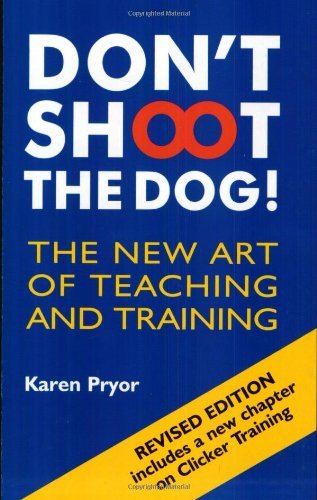 By Karen Pryor - Don't Shoot the Dog!: The New Art of Teaching and Training (3rd Revised edition)
By Karen Pryor - Don't Shoot the Dog!: The New Art of Teaching and Training (3rd Revised edition)We're going to briefly depart from the main message of the article to discuss the common tactic of yelling commands at the dog to try to get him to stop jumping up. We think is a silly idea, and can also be very counter-productive. You want the dog to never jump up as a piece of habitual good manners, so there is never any need to teach the dog cues associated with jumping up. If the dog never jumps up, you certainly won't need a cue to get the dog back on the ground, and the goal is for the dog to never jump up.
Aside from the inherent silliness of teaching the dog a "stop jumping" command, if you go around shrieking OFF at your jumping dog and then reward your dog in some way when he stops jumping you are in grave danger of teaching a behavioral chain. Behavioral chains are extremely useful in dog training. We want our dog to go pick up the dummy, bring it back and sit all on one command- that's a behavioral chain, a series of discrete, chained behaviors the dog performs in order to earn a final reward at the end.
Dogs very readily learn behavioral chains, which is great news for us humans- most of the time. The problem is they sometimes learn behavioral chains we don't really want them to learn. For example, your dog barks, you tell him to be quiet, and then when he stops barking you give him a cookie. Pretty soon whenever your pet wants a cookie he'll start barking because he's learned that will trigger you to say quiet and then reward him. The exact same thing happens with dog owners who wait for the jumping, then tell their leaping dog "off" and then reward in some way- basically, you're teaching your pet to go jump on people as part of a behavioral chain.
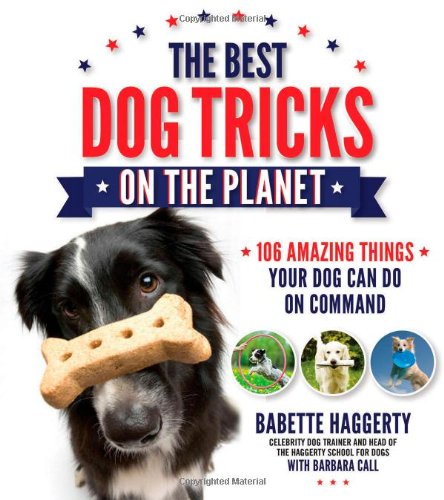 The Best Dog Tricks on the Planet: 106 Amazing Things Your Dog Can Do on Command
The Best Dog Tricks on the Planet: 106 Amazing Things Your Dog Can Do on CommandSo back to the problem of other people rewarding your pet for jumping up on them. We and others have realized that there is really only one workable solution to this problem. You have to teach your pet a greeting behavior for strangers that is incompatible with jumping up on people.
Most people are very happy to meet a dog that sits and offers a paw in greeting, and it's physically impossible for a dog to jump up on someone while sitting. So we suggest working on teaching this kind of greeting behavior. You will also have to continue not-rewarding any jumping up the dog offers, of course.
Simply teach the dog a sit and offer the paw, and put it on a verbal cue at first. Eventually you'll want the cue to be the appearance of a stranger, but right now you need to be able to elicit the behavior on demand. Once he's pretty solid at sit and offer a paw at home, invite some guests over so he can practice greeting them. Then take it on the road. Go to the park, go to the pet store, anywhere. Try to find willing strangers to happily greet your dog in this new way, and reward your pet well for greeting politely- the dog's primary reward for greeting politely will be attention from the stranger, but it doesn't hurt for you to praise and maybe treat as well during the initial learning phase. As soon as your dog seems to catch on, stop verbally cueing your pet to sit and wait for him to start offering it as a greeting instead.
Many dogs catch on to this with incredible speed, and sometimes they seem relieved to have finally learned a greeting behavior that everyone likes. For example, we recently worked with a very large 3-year-old retriever mix. She had been jumping up on people with great vigor her whole life, and while she got rewarded with attention for jumping she did seem to pick up on the negative vibes about her behavior from everyone- not to mention her owners had engaged in some pretty brutal physical punishments in an (ineffective) effort to stop her, so greetings for her were filled with tension and confusion. She wanted to be friendly, but didn't know how to do so in human terms.
Once we showed her that she could sit and offer a paw and be greeted with joy by everyone she was astounded- and very, very relieved. She was a very friendly animal, after all, and didn't really understand why no one seemed very receptive to her attempts to be friendly before.
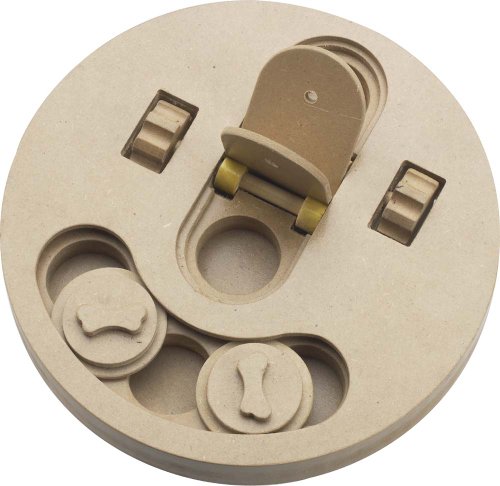 Ethical Pet Seek-A-Treat Flip 'N Flap Dog Puzzle
Ethical Pet Seek-A-Treat Flip 'N Flap Dog Puzzle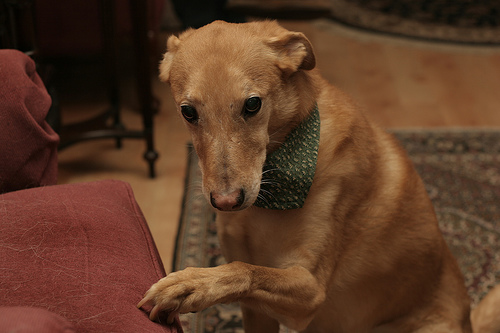 Redecorating For Your Dog- How To Make Your Home More Dog Friendly
How To Make Your Home More Dog Friendly
I know that I would
Redecorating For Your Dog- How To Make Your Home More Dog Friendly
How To Make Your Home More Dog Friendly
I know that I would
 Indipet Slow Feed Pet Bowl
If you have a dog that loves
Indipet Slow Feed Pet Bowl
If you have a dog that loves
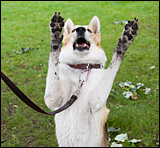 Dog Tricks – Dog Training Level 2
Dog Tricks – Dog Training Le
Dog Tricks – Dog Training Level 2
Dog Tricks – Dog Training Le
 How to Choose a Puppy
Hes cute, but how big will he get? Cred
How to Choose a Puppy
Hes cute, but how big will he get? Cred
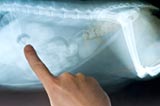 Why Vet Care is So Expensive
Why Vet Care is So Expensive
Why Vet Care is So Expensive
Why Vet Care is So Expensive
Copyright © 2005-2016 Pet Information All Rights Reserved
Contact us: www162date@outlook.com